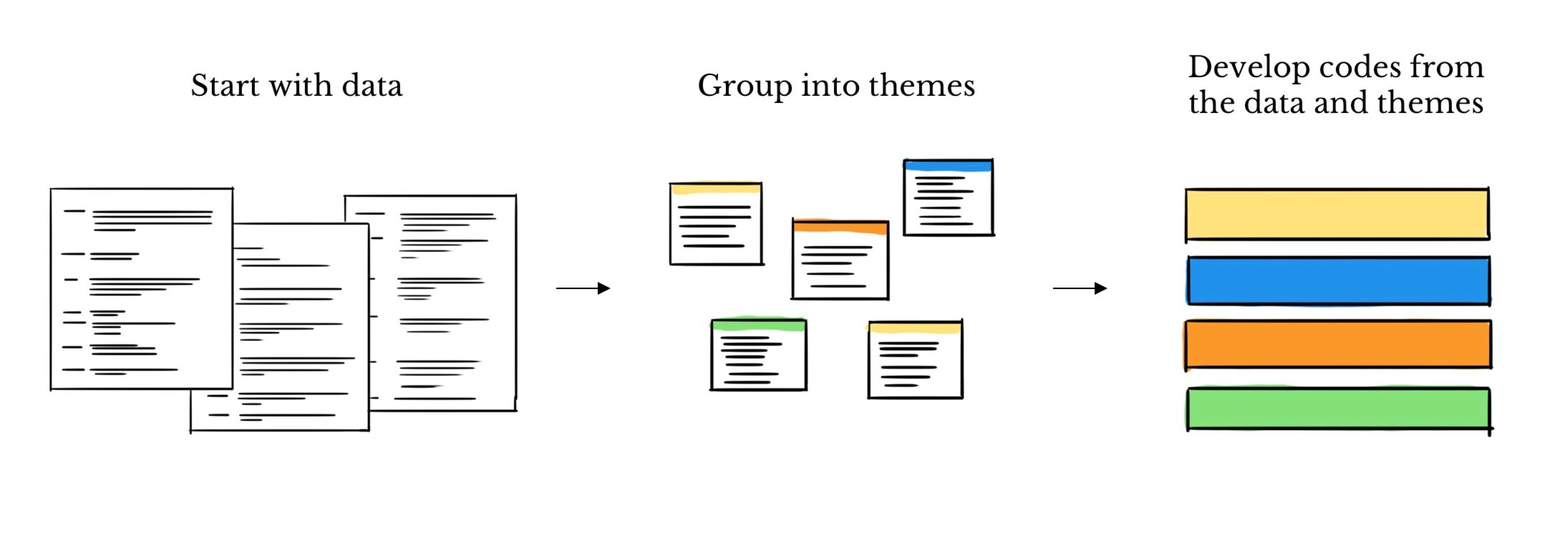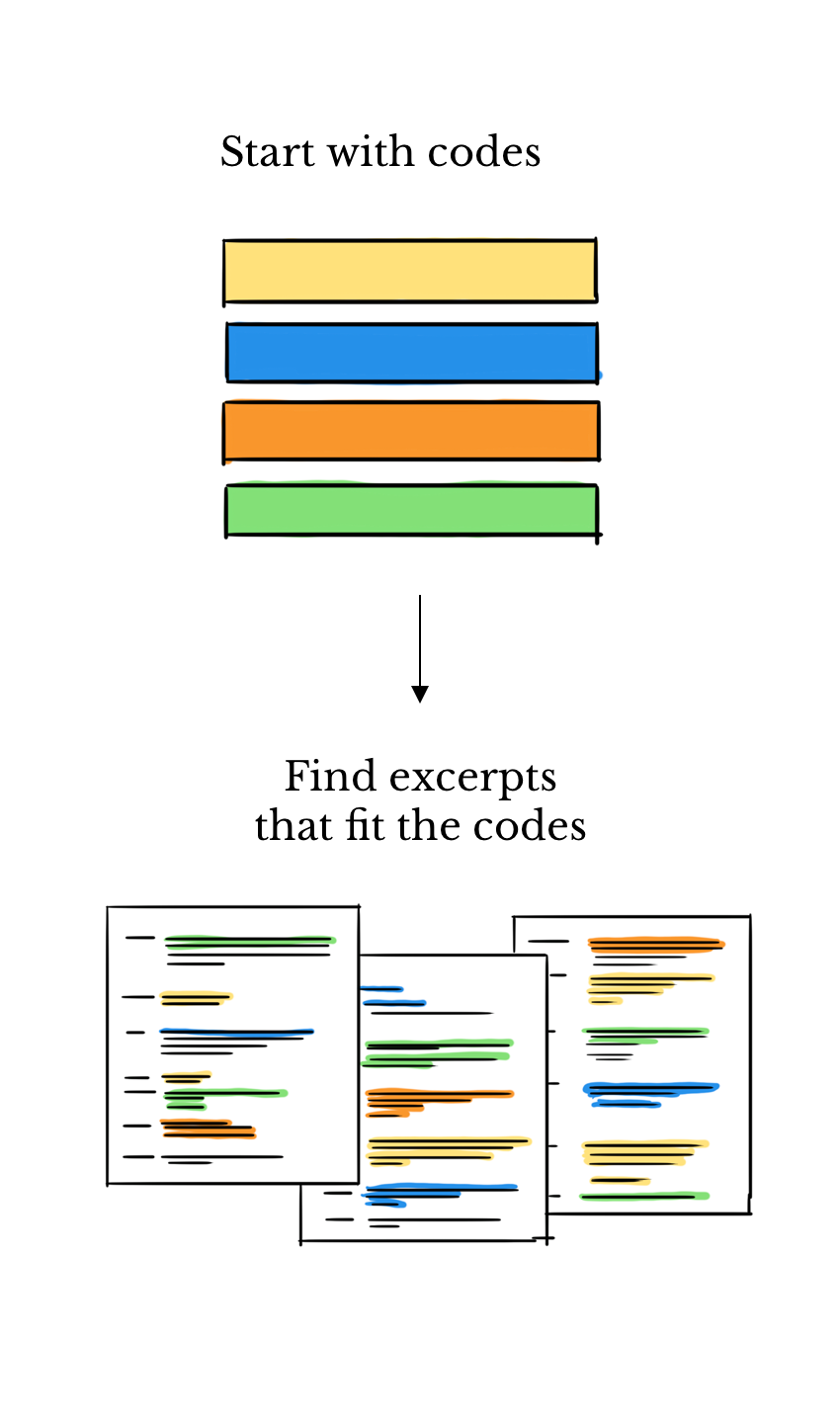

The process of coding qualitative data is an important part of the analytical process of analyzing qualitative research. When you generate data from qualitative methods such as semi-structured interviews, qualitative coding allows you to interpret, organize, and structure your observations and interpretations into meaningful theories. Coding in qualitative research allows you to be reflexive, critical, and rigorous with your findings. Continue reading to learn more about coding in research.
Qualitative research is research that utilizes non-numerical from methods such as observations, in depth interviews, or focus groups, or by analyzing content such as documents, or records. Analysis deals with words, meaning, and interpretation.
There are many methods of qualitative data collection methods, and each have their own unique advantages and disadvantages. You should select a qualitative methodology that is best suited for answering your research questions. There are more methodologies than what I’ve listed here, but here are some examples.
Qualitative data is non-numerical data that is produced from qualitative research methods. Any of these can be used in data coding.

After conducting an interview, transcription will allow you to take the contents of the interview and effectively analyse it. Coding interviews requires a transcript. You can transcribe with varying levels of specificity, and utilize various methods from doing it manually, with auto-transcription software, or by outsourcing to transcription services.
When transcribing, choose the type of transcription you want to do, then listen to audio and type out the transcription while designating who the speaker is, a timestamp, and the dialogue contents of the transcription. These transcriptions are the first step for coding interviews.

Qualitative coding is a process of systematically categorizing excerpts in your qualitative data in order to find themes and patterns.
It enables you to take unstructured or semi-structured data such as transcripts from in-depth interviews or focus groups and structure it into themes and patterns for analysis.
Coding your qualitative data makes your analysis more systematic and rigorous. It also provides transparency and reflexivity to both yourself and others.
It’ll enable you to find insights that are truly representative of your data and the human stories behind them.
The process of coding qualitative data varies widely depending on the objective of your research. But in general, it involves a process of reading through your data, applying codes to excerpts, conducting various rounds of coding, grouping codes according to themes, and then making interpretations that lead to your ultimate research findings. You may start with an initial round of coding to summarize or describe excerpts, and then do a second round of coding that adds your own interpretive lens.
There’s no right or wrong way to code a set of data, just some approaches that are more or less appropriate depending on your research objective. Below are various types of coding, which you can mix and match according to what works for you.
Before coding in qualitative research, you should decide if you want to start off with a set of codes and stick with them (deductive coding), come up with the codes as you read what you see in your data (inductive coding), or take a combination approach.
Ground up coding
Inductive coding is a ground-up approach where you derive your codes from the data. You don’t start with preconceived notions of what the codes should be, but allow the narrative or theory to emerge from the raw data itself. This is great for exploratory research or times when you want to come up with a new theories, ideas or concepts.

Top down coding
Deductive coding is a top down approach where you start by developing a codebook with your initial set of codes. This set could be based on your research questions or an existing research framework or theory. You then read through the data and assign excerpts to codes. At the end of your analysis, your codes should still closely resemble the codebook that you started off with. This is good when you have a pre-determined structure for how you need your final findings to be. For example, program evaluation studies may utilize a deductive coding approach.

In practice, research studies often combine both deductive and inductive approaches to coding. For example, you could deductively start with a set of codes, but then inductively come up with new codes and iterate on the codes as you sift through your data.
How to do coding:
Your first round pass of coding qualitative data involves reading the data and assigning codes to various excerpts. This step is fast and loose. Don’t worry so much about creating the perfect codes since you’ll be iterating and evolving the codes as you go onto the second pass at coding, and beyond.
So how do you determine what to name the codes and what parts of the data to code? Here are some examples of types of coding methods that are commonly used in the first round pass.
Examples of coding:
Using the participant’s own words
With In Vivo coding, you code an excerpt based on a participant’s own words, and not your own interpretation as a researcher. You’re trying to utilize the participant’s own spoken language and stay as close to their intent and meaning as possible. In Vivo coding is often used as a first step to summarize passages into single words or phrases extracted from the interview itself. It is a common form of interview coding.
Capturing an action
With Process coding, you use codes to communicate an action in the qualitative data. Codes will typically be gerunds that end with “ing”.
An initial round of loose and tentative coding
With Open coding, you break down the qualitative data into discrete excerpts. The codes represent a label, description, definition, or category name. The codes produced in a round of open coding are meant to be loose and tentative and subject to evolve and change as you code in further rounds.
With Descriptive coding, you summarize the content of the text into a description. The code name should be a word or a noun that encapsulates the contents of the qualitative data.
With structural coding, you categorize sections of your text according to a specific structure with the intent to continue analyzing within these structures. It’s a way to break your qualitative data into smaller increments. For example if you’re analyzing a semi-structured interview, you may have a question-based code that classifies all the answers to that question.
With Values coding, you code excerpts that pertain to the participant’s values, attitudes, and beliefs.
Simultaneous coding is a method of qualitative coding where a single excerpt of qualitative data is coded with multiple codes.
After your first round pass at coding qualitative data, you can begin to group your codes into categories. These categories can be organized in a variety of ways. Within each category, you can group together codes that are similar to each other, or pertain to the same topics or general concept. Iterate on these categories and move the codes around until you find a structure that makes sense for your analysis.
Next, do further rounds of coding qualitative data to re-examine the codes and categories you’ve created so far. In this phase, you may re-name, re-code, merge codes, and re-categorize the work you’ve done so far. While the first round pass at coding data was fast and loose, these rounds of coding are about reanalyzing, finding patterns, and getting closer to developing theories and concepts.
In general, you should be reducing the number of codes from your initial round of coding, and actively reflecting on how to best categorize the codes you have.
Here are some methods of coding qualitative data that are commonly used in second-round coding and beyond. Read about various types of coding.
Find recurring patterns and themes
Thematic analysis coding is utilized when you’re looking for themes or patterns across your qualitative data set. If you find a pattern within different parts of your qualitative data or see that certain excerpts point to the same underlying idea or meaning, code those excerpts with a unifying code.
With Pattern coding, you group similarly coded excerpts under one overarching code to describe a pattern.
With Focused coding, you create a finalized set of codes and categories from your first coding pass (often from “open coding”). You then re-code the qualitative data according to this final code list with the intent to not deviate from it. In comparison to an initial “open coding” pass which allows for emergent and changing codes, focused coding is a method where you don’t intend to change the code list any further.
With axial coding, you relate codes or categories to one another. You’re looking for relationships and links between what you found in earlier rounds of coding.
With theoretical coding, you conceptualize a hypothesis of a theoretical framework through sorting and organizing codes. You structure the codes and categories that emerged from qualitative data into a theory.
With elaborative coding, you apply a theory from a previous research study and observe whether or not your current codes and categories relate. You can think about it as elaborating on pre-existing theories.
With longitudinal coding, you organize your existing codes and categories in a way that enables you to compare them over time.
With content analysis, you examine and understand the content of textual data. There are two types of methodological approaches to content analysis: quantitative content analysis and qualitative content analysis.
After these rounds of coding qualitative data, and doing various types of coding, you take those codes and categories and use them to construct your final narrative. Depending on the purpose of your research, the final outcome of your research can take many forms: a theory, a set of findings, or a narrative. In this phase you combine the creativity of structuring a narrative with the analytical nature of connecting your narrative to your codes and theories grounded in qualitative data.
Start writing out your theory, findings, and narrative, and reference the codes and categories that were used to inform them. Now, structure these into your final research deliverable.
Online qualitative research software such as Delve can help streamline how you’re coding your qualitative coding. Try a 14 day free trial of Delve.
It is important to consider validity and reliability when conducting qualitative research no matter what type of coding you’re practicing. Here are some approaches you can consider practicing to increase your research’s reliability.
Peer briefing is the process of working with one or more neutral, independent peers to enhance the credibility of qualitative research.
Reflexivity involves examining your own judgments, practices, and belief systems during the data collection process. The goal of being reflexive is to identify any personal beliefs that may have incidentally affected the research.
Intercoder reliability ensures that when you have multiple researchers coding a set of qualitative data, that they come to the same conclusions.
Negative case analysis involves finding and discussing contradictory qualitative data emerging from your working hypothesis or theory.
End-to-end coding methods are structured and proven qualitative research approaches. They provide researchers with a systematic workflow to follow from the beginning of their research to the final write-up.
Some end-to-end methods are also considered second-round coding methods. Because studies can employ one or more research methods, you may find some scenarios where you blend methods and approaches together.
Here’s a practical introduction to several end-to-end coding methods:
Interpretive phenomenological analysis (IPA) is a qualitative research methodology that explores how individuals make sense of their experiences.
It is an inductive research method that begins with specific examples and uses them to develop broader theories. IPA researchers collect data (e.g. via interviews) and analyze it to uncover themes and meanings to help them understand how individuals make sense of their experiences.
IPA requires the researcher to bracket whatever a priori assumption they have about the experience or phenomenon. Bracketing is when researchers reflexively engage with the data to document their own biases or beliefs about what participants say.
Thematic analysis is a qualitative data analysis method that involves reading through a data set (such as transcripts from in-depth interviews or focus groups) and identifying patterns of meaning across the data to derive themes. Like IPA, thematic analysis also involves an active process of reflexivity, where a researcher’s subjective experience plays a central role in meaning-making from data.
Read more about thematic analysis - watch more about thematic analysis. ↓